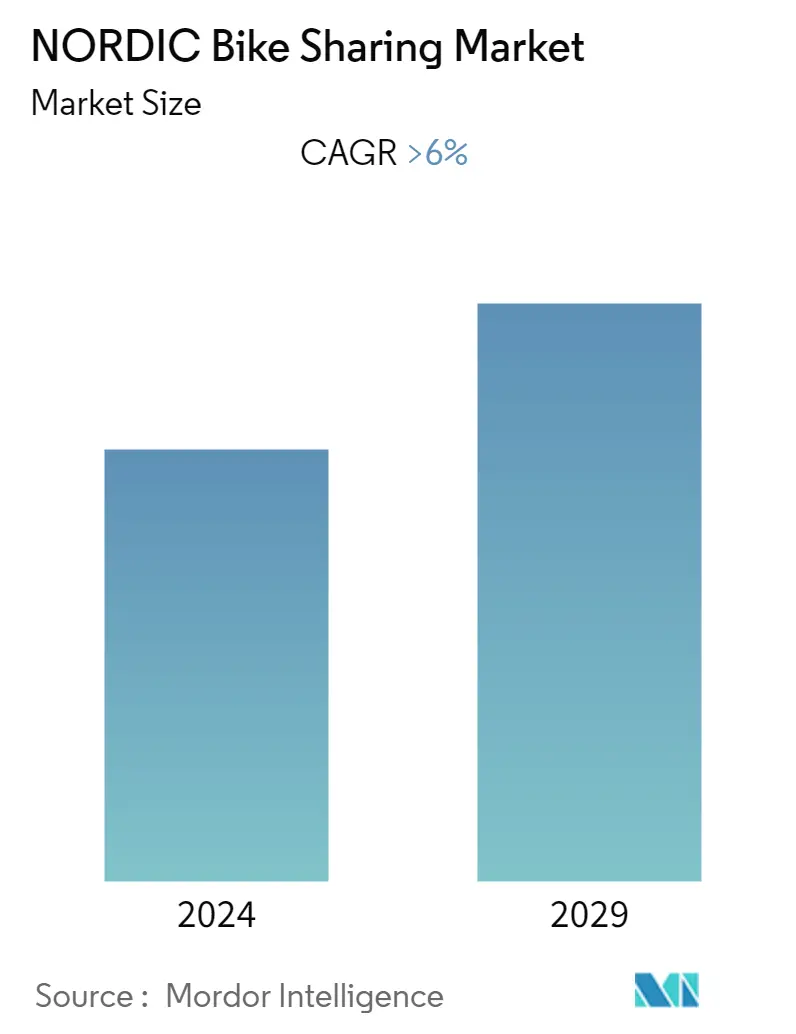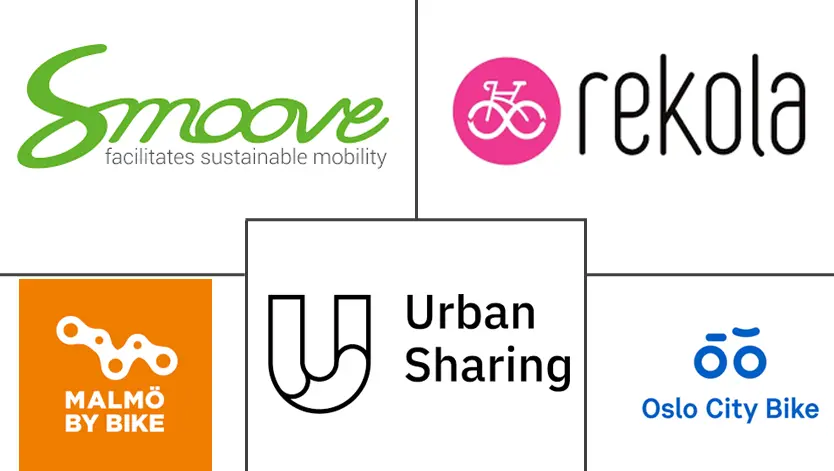
| Study Period | 2019 - 2029 |
| Base Year For Estimation | 2023 |
| Forecast Data Period | 2024 - 2029 |
| Historical Data Period | 2019 - 2022 |
| CAGR | 6.00 % |
| Market Concentration | Medium |
Major Players
*Disclaimer: Major Players sorted in no particular order |
NORDIC Bike Sharing Market Analysis
The NORDIC bike-sharing market is poised to register a CAGR of over 6% during the forecast period (2020-2025).
- NORDIC cities are implementing stricter regulations such as prohibiting the entry of motor vehicles in city centers and promoting electric vehicles in public transport, and other environment-friendly alternatives in city centers such as bike-sharing/ e-bike sharing.
- Increasing traffic congestion, insufficient mass public transport, increasing rates of road fatalities, growing awareness among peoples for environmental concerns, will drive the bike-sharing market. Bike-sharing provides a convenient way of transportation at minimum cost without any hassle.
- The current bike-sharing platforms are using various technologies such as IoT, QR codes, smart-locks, and GPS technology for providing dockless bike-sharing services. Dockless sharing does not have the requirement to distribute the fleet and from the user perspective, they don't have to face the hassle of finding an available docking station.
- Citizens of countries such as Norway were always surrounded by digital solutions, and they trust on technology. Another fact which supports this point is strong network connectivity throughout the country, which supports online bike-sharing schemes.
NORDIC Bike Sharing Industry Segmentation
The NORDIC bike-sharing market is segmented by bike type (traditional/regular bike and e-bike rental), sharing system (docked and dockless), and by Country.
| Traditional/Regular Bike |
| E-bike |
| Docked |
| Dockless |
| Sweden |
| Norway |
| Finland |
| Denmark |
| Rest of Nordic Region |
NORDIC Bike Sharing Market Size Summary
The bike-sharing market in the Nordic countries is experiencing significant growth, driven by a combination of environmental initiatives and technological advancements. Cities in this region are increasingly implementing regulations that favor sustainable transportation options, such as bike-sharing and e-bike sharing, by restricting motor vehicle access in city centers and promoting electric vehicles. This shift is fueled by rising traffic congestion, inadequate public transport, and a growing awareness of environmental issues. The adoption of advanced technologies like IoT, QR codes, smart locks, and GPS has facilitated the development of dockless bike-sharing services, which offer users greater convenience by eliminating the need for docking stations. The strong digital infrastructure and trust in technology among Nordic citizens further support the expansion of these services.
The commitment to carbon neutrality, as evidenced by the declaration signed by Finland, Sweden, Norway, Denmark, and Iceland, underscores the importance of cycling as a sustainable urban transport solution. Cities like Helsinki are leading the way in promoting cycling, with plans to increase the percentage of journeys made by bicycle. The introduction of e-bikes has also enhanced the appeal of bike-sharing, as they provide assistance for longer distances. The market is characterized by a fragmented landscape with numerous regional players and new startups entering the scene, driven by factors such as advanced technology, user-friendly rental schemes, and increased investment. Companies like JCDecaux and oBike are expanding their presence and incorporating innovative features to enhance the user experience, while partnerships, such as that between CityBike and Stage Intelligence, are integrating artificial intelligence into bike-sharing platforms.
NORDIC Bike Sharing Market Size - Table of Contents
1. MARKET DYNAMICS
- 1.1 Market Drivers
- 1.2 Market Restraints
-
1.3 Industry Attractiveness - Porter's Five Forces Analysis
- 1.3.1 Threat of New Entrants
- 1.3.2 Bargaining Power of Buyers/Consumers
- 1.3.3 Bargaining Power of Suppliers
- 1.3.4 Threat of Substitute Products
- 1.3.5 Intensity of Competitive Rivalry
2. MARKET SEGMENTATION
-
2.1 By Bike Type
- 2.1.1 Traditional/Regular Bike
- 2.1.2 E-bike
-
2.2 By Sharing System Type
- 2.2.1 Docked
- 2.2.2 Dockless
-
2.3 By Country
- 2.3.1 Sweden
- 2.3.2 Norway
- 2.3.3 Finland
- 2.3.4 Denmark
- 2.3.5 Rest of Nordic Region
NORDIC Bike Sharing Market Research FAQs
What is the current NORDIC Bike Sharing Market size?
The NORDIC Bike Sharing Market is projected to register a CAGR of greater than 6% during the forecast period (2025-2030)
Who are the key players in NORDIC Bike Sharing Market?
Oslo City Bike, Urban Sharing, Smoove, Rekola and Malmö By Bike are the major companies operating in the NORDIC Bike Sharing Market.


